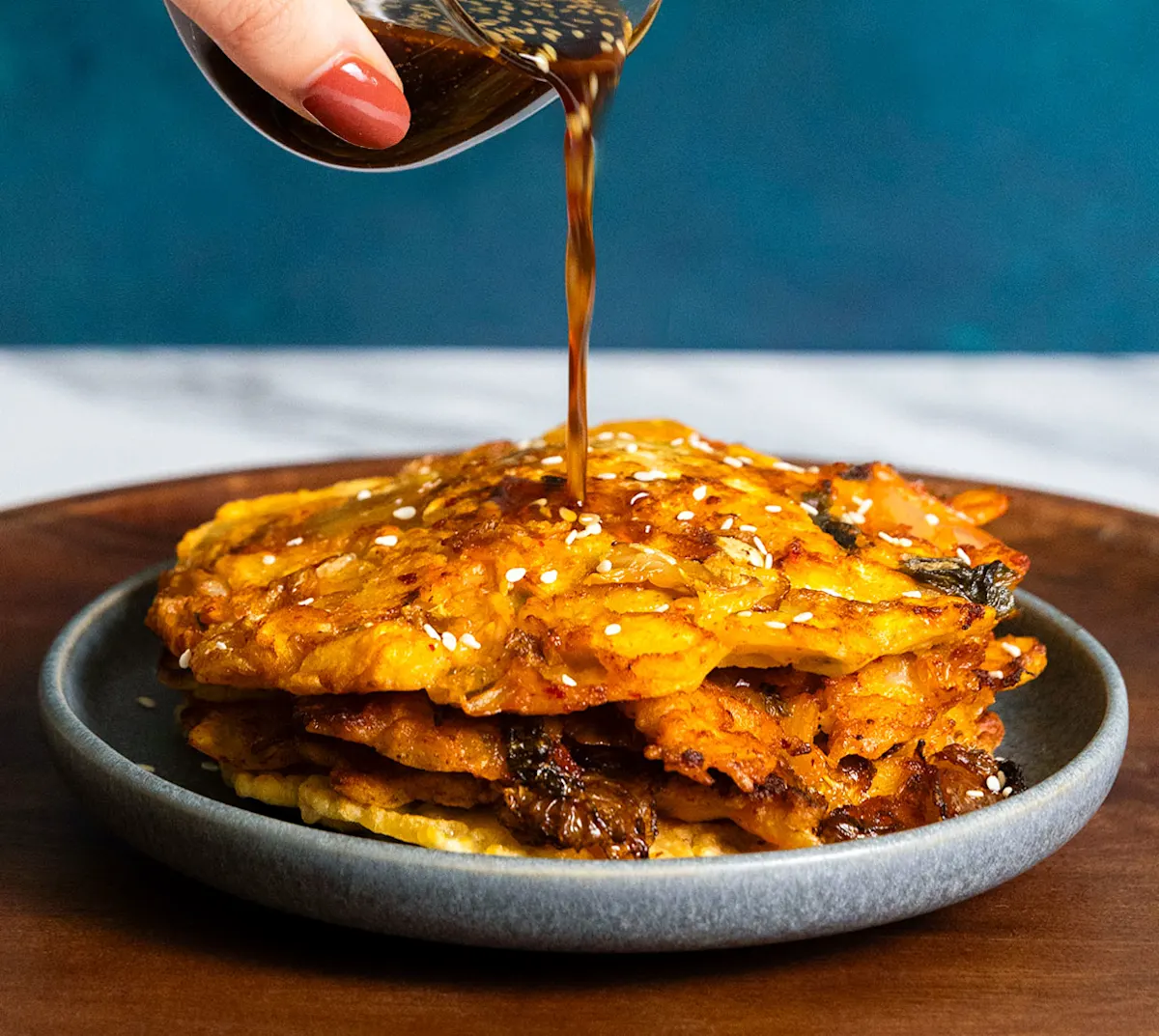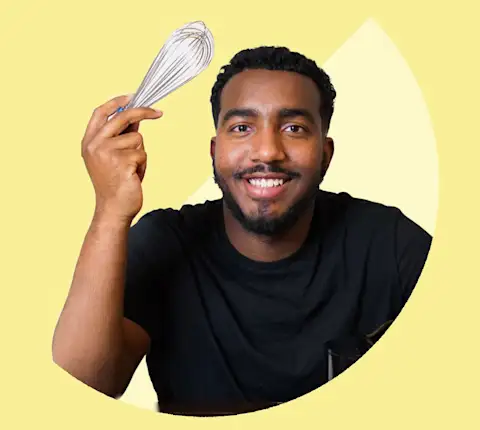When you think of a stack of pancakes, you probably imagine lots of butter and maple syrup. I think about shrimp. Because my platonic ideal of pancakes is jeon — Korean savory pancakes! — which are equally great in the morning, afternoon, evening, or as a late-night snack.
I’ve been going through a jeon journey for decades. There are two main styles of jeon that I buy and make.
The first is the more fritter-like jeon made of sliced meat, fish, and vegetables that are simply dipped in flour, egg, or a combination, and pan-fried. It’s barely a batter, light and crisp, and some of my faves are daegu-jeon (cod), hobak-jeon (zucchini), and donggeurang-ttaeng (little patties made of beef or pork, tofu, and scallions).
The second style, which I spot at almost every table when I go to Korean BBQ, is pajeon, a savory pancake filled with vegetables, seafood, or some combination.
Pajeon was one of the first Korean foods I fell in love with. It wooed me with its crisp edges, chewy texture, and borderline excessive amount of scallions inside. (There’s also a version called haemul-pajeon with seafood!) The scallions are dramatic in pajeon — they’re halved or cut into long strips lengthwise and cooked into one large pancake (at least 10 inches and often larger) that is cut or snipped into triangles with kitchen shears, sometimes tableside at restaurants.
Although I love the look of the pajeon style, I found when developing my own recipe that it was hard to cut my teeth through such long scallions, making for stringy and awkward bites. Honey, I shrunk the jeon, opting for smaller, approximately 3- to 4-inch-wide pancakes that are more manageable to both make (aka flip!) and eat.
My Anything-Goes Jeon ended up being more like yachaejeon (vegetable pancakes) than simple pajeon because you can throw almost any veggie in and have a great meal of sturdy, savory pancakes.
One of my favorite discoveries in my jeon journey has been using zucchini noodles to save on prep time. They are so thin that they cook quickly right in the batter as the jeon crisps up, and then can be cut down to fit into smaller pancakes. Although zucchini has a lot of water content, this small amount doesn’t leach water into the batter. However, mushrooms do, so pre-cook and season your sliced mushrooms before adding ’em! Same goes for eggplant, but shredded carrots, small broccoli florets, grated potato (Russet or sweet), and frozen or canned corn can all go in raw. Little pieces of leftover meat or fish could also be added easily to save your leftovers from being trashed.
The best part? Jeon reheats beautifully for meal prep and can also be scaled up easily for party bites with a dynamic dipping sauce.
Anything-Goes Jeon (Korean Savory Pancakes)
Serves: 4 to 6

Prep Time: 10 minutes
Cook Time: 20 minutes
Total Time: 30 minutes
For the dipping sauce (makes ⅓ cup):
2 tablespoons soy sauce
2 tablespoons unseasoned rice vinegar
2 teaspoons fish sauce
1 teaspoon honey
1 teaspoon garlic powder
1 teaspoon gochujang
1 tablespoon hot water
2 teaspoons sesame oil
A good shake of toasted sesame seeds
1 scallion, dark green parts only, thinly sliced or snipped
For the jeon:
¾ cup all-purpose flour
½ cup potato starch
½ teaspoon baking powder
1 teaspoon kosher salt
1 teaspoon garlic powder
1 teaspoon onion powder
¼ teaspoon ground white pepper
1 egg
1 tablespoon soy sauce
1 cup cold water (plus a splash more if needed)
4 crab sticks (aka imitation crab or surimi) or 6 peeled and deveined shrimp, cut in half lengthwise.
1 bunch scallions, cut into 3 or 4 pieces lengthwise, then thinly sliced (they should look like ribbons)
¼ cup grated or shredded carrots (store-bought bag is totally fine)
½ cup zucchini noodles (spiralized zucchini), cut into similar length of scallions*
½ cup neutral oil (such as canola or vegetable), for frying
*You can also use corn, broccoli, kimchi, grated potato, sliced and sautéed mushrooms… whatever you have around.
First, make the dipping sauce. Combine all ingredients in a small bowl and whisk to combine. Taste to see if it needs more spice or sweetness for your liking and add more gochujang or honey accordingly. Set aside.
In a large bowl, whisk together the flour, potato starch, baking powder, kosher salt, garlic powder, onion powder, and white pepper. In a separate medium bowl, whisk together the egg, soy sauce, and water. Add the wet ingredients to the dry ingredients and whisk gently to combine. The batter should be smooth and slightly runnier than a traditional pancake batter — somewhere between a crepe and a pancake. A few lumps are okay, but make sure there aren’t any pockets of flour hiding in there.
If using crab sticks, cut into thirds lengthwise and then thinly slice (or rub between your palms to instantly shred). They should be a similar length to the scallions. Mix in your scallions, carrots, zucchini, and crab sticks (or the other odds-and-ends of vegetables and meat you’re using).
Add the oil to a large skillet and heat over medium for stainless steel or cast iron and medium-high for nonstick. Let it heat up for at least 3 minutes, flicking a bit of batter inside the oil — if it bubbles immediately, then it’s hot enough!
Using tongs or a fork, pile the fillings into a 1/3 measuring cup. Immediately (and carefully) turn that over into the skillet, and then get another tablespoon or so of batter in the cup and drizzle it over the top where some of the fillings may be poking out. The goal is to cover the surface of all of the mix-ins. Repeat with as many as can comfortably fit in the skillet without touching.
Let the pancakes cook undisturbed for 3 minutes. Use a chopstick or spatula corner to poke a few holes in the batter so a little steam can escape and help with speedier, more even browning. After another 2 minutes, lift an edge up with a spatula to see if it looks golden brown evenly across the surface; if not, let it sit another 1 to 2 minutes, then flip. Let cook for another 3 to 5 minutes, until crisp and golden, flipping again if there are any blonde spots on either side.
Remove from the skillet with a slotted spatula or tongs onto a paper towel-lined plate, preferably on a wire rack, to drain. Serve whole or cut (using kitchen shears) into quarters with the dipping sauce. If you have leftovers, store in an airtight container with a paper towel to absorb excess grease and moisture for up to 4 days. Reheat in an air fryer at 350°F for 5 to 7 minutes, or in a dry skillet over medium heat until warmed through and crisped again, about 2 minutes per side.
PHOTO CREDIT:
Photographer: Natassja Ebert
Food Styling: Mary Rupp
Art Direction: Sarah Ceniceros Gomez






